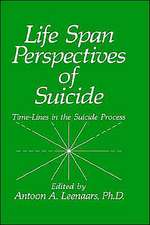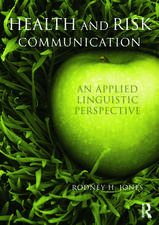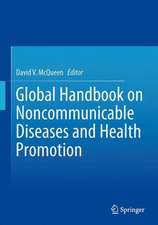Smoking Prevention and Cessation
Autor Giuseppe La Torreen Limba Engleză Paperback – 4 aug 2015
| Toate formatele și edițiile | Preț | Express |
|---|---|---|
| Paperback (1) | 1105.21 lei 43-57 zile | |
| Springer Us – 4 aug 2015 | 1105.21 lei 43-57 zile | |
| Hardback (1) | 1112.54 lei 43-57 zile | |
| Springer Us – 2 iul 2013 | 1112.54 lei 43-57 zile |
Preț: 1105.21 lei
Preț vechi: 1163.38 lei
-5% Nou
Puncte Express: 1658
Preț estimativ în valută:
211.55€ • 229.87$ • 177.82£
211.55€ • 229.87$ • 177.82£
Carte tipărită la comandă
Livrare economică 21 aprilie-05 mai
Preluare comenzi: 021 569.72.76
Specificații
ISBN-13: 9781489996398
ISBN-10: 1489996397
Pagini: 478
Ilustrații: VIII, 478 p. 77 illus.
Dimensiuni: 155 x 235 x 25 mm
Greutate: 0.69 kg
Ediția:Softcover reprint of the original 1st ed. 2013
Editura: Springer Us
Colecția Springer
Locul publicării:New York, NY, United States
ISBN-10: 1489996397
Pagini: 478
Ilustrații: VIII, 478 p. 77 illus.
Dimensiuni: 155 x 235 x 25 mm
Greutate: 0.69 kg
Ediția:Softcover reprint of the original 1st ed. 2013
Editura: Springer Us
Colecția Springer
Locul publicării:New York, NY, United States
Descriere
The cravings, the compulsive behaviors, the potential fatal health consequences--once considered relatively harmless, tobacco use is now understood to have addictive properties similar to those of hard drugs. Dependence on tobacco and nicotine from smoking, chewing, or other means affects millions around the world, and for countless people it remains resistant to efforts to quit despite the level of intervention or number of attempts.
Smoking Prevention and Cessation addresses this longstanding problem on various biological, societal, and psychological fronts. This extensively researched volume traces the mechanics of smoking initiation, nicotine dependence and withdrawal, and motivation to quit. Chapters analyze smoking as a global public health issue, review the epidemiology of smoking-related disease, and evaluate prevention and cessation interventions (pharmacology included) as applied to different settings and populations. The detailed, data-rich presentation gives readers a rounded, realistic understanding of smoking on a worldwide level as the book:
Researchers and graduate students in public health, health promotion, behavioral medicine, and smoking cessation will find Smoking Prevention and Cessation a unique reference packed with evidence-based insights and practical, workable ideas.
Smoking Prevention and Cessation addresses this longstanding problem on various biological, societal, and psychological fronts. This extensively researched volume traces the mechanics of smoking initiation, nicotine dependence and withdrawal, and motivation to quit. Chapters analyze smoking as a global public health issue, review the epidemiology of smoking-related disease, and evaluate prevention and cessation interventions (pharmacology included) as applied to different settings and populations. The detailed, data-rich presentation gives readers a rounded, realistic understanding of smoking on a worldwide level as the book:
- Introduces measurement tools for gauging nicotine dependence.
- Examines the media in tobacco advertising and smoking prevention messages.
- Analyzes "what works" in prevention approaches.
- Compares the efficacy of cessation interventions.
- Pinpoints issues specific to smoking among health professionals and youth.
- Reviews economic, bioethics, and policy issues related to smoking.
Researchers and graduate students in public health, health promotion, behavioral medicine, and smoking cessation will find Smoking Prevention and Cessation a unique reference packed with evidence-based insights and practical, workable ideas.
Cuprins
Chapter 1:From nicotine dependence to motivation to stop smoking.- 1.1Introduction: Denial and Delay.- 1.2Tobacco and nicotine.- 1.2.1What is Nicotine?.- 1.3Addiction and Nicotine addiction.- 1.4Nicotine withdrawal.- 1.5How to measure nicotine dependence.- 1.5.1Fagerstrom Tolerance Questionnaire.- 1.5.2Fagerstrom Test for Nicotine Dependence.- 1.6Motivation to stop smoking.- Chapter 2:State of the art of smoking habits in the world.- 2.1 Introduction: the tobacco epidemic.- 2.2 Data on incidence, prevalence, by gender, age-groups, ethnic groups.- 2.2.1 Tobacco consumption by gender and adults in the six major regions of the world.- 2.2.2 Tobacco consumption by adolescents in the six major regions of the world.- 2.2.3 Ethnic groups.- 2.3 Passive smoking.- 2.3.1 Secondhand smoking.- 2.3.2 Thirdhand smoking.- Chapter 3:Smoking-related diseases epidemiology.- 3.1Introduction.- 3.2 Cardiovascular diseases.- 3.2.1 Coronary Heart Disease.- 3.2.2 Hypertension.- 3.2.3 Cerebro-Vascular Disease.- 3.2.4 Aortic Aneurism.- 3.3 Respiratory diseases.- 3.3.1 Chronic Obstructive Pulmonary Disease (COPD).- 3.3.2 Chronic Bronchitis.- 3.3.3 Emphysema.- 3.3.4 Asthma.- 3.4 Cancers: main smoking-related cancers.- 3.4.1 Lung Cancer.- 3.4.2 Cancer of the Larynx.- 3.4.3 Cancer of the Oesophagus.- 3.4.4 Lower urinary tract.- 3.4.5 Pancreatic Cancer.- 3.4.6 Stomach Cancer.- 3.4.7 Breast Cancer.- 3.4 Other diseases.- 3.4.1 Acne.- 3.4.2 Low Birth Weight.- 3.4.3 Sudden Infant Death Syndrome (SIDS).- 3.4.4. Maculophaty.- 3.4.5 Smoking related allergy.- 3.4.6 Early Menopause.- Chapter 4 Smoking –related cancer epidemiology.- 4.1 Introduction.- 4.2 Cancers: main smoking-related cancers.- 4.3 Lung Cancer.- 4.4 Cancer of the Larynx.- 4.5 Cancer of the Esophagus.- 4.6 Lower urinary tract.- 4.7Pancreatic Cancer.- 4.8 Stomach Cancer.- 4.9 Breast Cancer.- Chapter 5 Classical determinants of smoking initiation.-5.1Introduction.-5.2 The role of the family.- 5.3The peer.-5.3.1Peer Socialization.- 5.3.2 Peer Selection.- 5.4The society.- 5.5Personal characteristics.-Chapter 6: Smoking prevention 6.1Introduction -Smoking prevention at school.- 6.1.1.Data on incidence and prevalence among adolescents.- 6.1.2Smoking prevention interventions at school.- 6.1.3Community interventions.-6.1.4Evidence-based recommendations and guidelines.- 6.2Smoking prevention in the workplace-Introduction.- 6.2.1Data on incidence and prevalence among workers.- 6.2.2Workplace interventions for smoking cessation.- 6.2.3Smoking-free workplace legislation.- 6.3Smoke free legislation.- Chapter 7.- 7.1Mass Media campaigns.- 7.1.1Mass Media campaigns definition.- 7.1.2The use of mass media campaigns in Public Health.- 7.1.3Identifying the target audience.- 7.1.4Characteristics of the message: design, contents, emotional appeal and source.- 7.1.5Dissemination strategy and channel characteristics.- 7.2Mass Media campaigns in smoking prevention strategies.- 7.2.1Formative research, theory and evaluation.- 7.2.2 Audience segmentation.- 7.2.3Message appeal, contents, format and tone.- 7.2.4Channel selection and message placement.- 7.3Overview of the theoretical approaches of tobacco control mass media campaigns.- 7.3.1Input-output persuasion model.- 7.3.2Health beliefs model.- 7.3.3Theory of reasoned action (Theory of planned behavior).- 7.3.4Integrative model of behavior change.- 7.3.5Trans-theoretical model (or State of Changes).- 7.3.6Social learning (cognitive) theory (Bandura A. 1977).- 7.4Mass Media Campaigns: overview of scientific evidence.- 7.4.1Overview of scientific literature.- 7.4.2Effectiveness, opportunities and shortcomings of mass media campaigns in preventing smoking initiation.- 7.4.3Characteristics of Effective Mass Media Campaigns.- 7.4.4Expert conclusions on Mass Media Public Education Campaigns.- 7.4.5Identified research gaps.- 7.5Mass Media Campaigns: evidence into practice.- 7.5.1Main umbrella organizations involved (e.g.WHO,EU. OECD).- 7.5.2The World Health Organization.- 7.5.3The European community.- 7.5.4Main National Public Health Agencies, including guidance/best practices delivery agencies.- 7.6Smoking Prevention: Mass Media campaigns worldwide.- 7.6.1Worldwide Mass Media campaigns targeted at general population and at specific demographic groups .-Chapter 8:How to tackle smoking at the population level.- 8.1The Tobacco free Framework.- 8.2EU legislation on tobacco.- 8.3Package advertising.- Chapter 9:Smoking among health professionals .- 9.1Introduction.- 9.2Smoking among Medical doctors.- 9.3Smoking Prevalence among Nurses.- 9.4Public awareness about smoking habits among Health Professionals.- 9.5Smoking among health profession students.- Chapter 10:Basic principles of smoking cessation techniques.- 10.1Introduction.- 10.2Transtheoretical approach Model (TTM).- 10.2.1Precontemplation.- 10.2.2Contemplation.-10.2.3Preparation.- 10.2.4Action.- 10.2.5Maintenance.- 10.3What is counseling?.- 10.3.1Counseling for Smoking Cessation.- 10.3.2Administrative aspects of counseling.- 10.4The 5 A’s and 3A’s approaches.- 10.4.15A's.- 10.4.23A's.- 10.5The evidence of counseling.- 10.6Medication for drug cessation 10.6.1First-line medications.- 10.6.1.1Nicotine Replacement Medications.- 10.6.1.2 Products not containing Nicotine.- 10.6.1.3The evidence of efficacy of first-line medications.- Chapter 11.- Smoking cessation among different settings.- 11.1Smoking cessation in the general population.- 11.2Smoking cessation in the clinical setting.- 11.3Smoking cessation in the workplace.- 11.4Smoking cessation among healthcare professionals.- 11.4.1Introduction.- 11.4.2The key role of health care providers in smoking cessation.- 11.4.3Prevalence of tobacco consumption among health care professionals.- 11.4.4Implementation of smoking cessation strategies: a review of current scientific literature.- 11.4.5Compared efficacy of various smoking cessation interventions.- 11.4.6Conclusions.- Chapter 12.- 12.1Introduction.- 12.2The Allen Carr book on “How to quit smoking”.- 12.3Information on the Web.- 12.4Web-based courses.- Chapter 13:Ethical aspects of tobacco smoking.-13.1Tobacco- smoking and public awareness : What Are the Risks?.- 13.1.1 Tobacco is not just killing smokers.- 13.1.2Do Smokers Voluntarily Accept the Risks?.- 13.2Individual rights.- 13.2.1Types and importance of individual rights: public health and other perspectives.- 13.2.2Human Rights.- 13.2.3Assumption: the Concept of “Public Health”.- 13.3Bioethical basis for global tobacco control.- 13.3.2Principles of bioethics.- 13.3.3Political outcomes.- 13.3.4Legal Paternalism, Nanny-statism, and the Defense of Public Health against Environmental Tobacco Smoke.- 13.3.5Social action: Is there a 'right' to advertise?.- 13.3.6Tobacco taxation and public health: ethical problems, policy responses.- 13.3.7Restrictions on smoking in public places.- 13.3.8Education, information and physician’s responsibility in promoting the patient’s health in the community, strongly supported by ethical arguments grounded in medical professionalism.- 13.4Burden of disease attributable to tobacco use and Tobacco-related costs.- Chapter 14:Economic issues related to tobacco smoking.- 14.1Production and supply of tobacco products.- 14.1.1Growing and manufacturing tobacco.- 14.1.2The costs of production.- 14.1.3Tobacco growing and manufacturing external effects.- 14.1.4Production policies.- 14.2Selling strategies and demand of tobacco products.- 14.2.1Models of demand for tobacco products.- 14.2.2Imperfectly rational addiction models.- 14.2.3Myopic rational addiction models.- 14.2.4Rational addiction.- 14.2.5Behavioral models.- 14.2.6Policy issues: prices, taxation and incentives.- 14.2.7Advertising.- 14.2.8Market diversification and emerging markets.- 14.3Caring for smoking related illnesses
Textul de pe ultima copertă
The cravings, the compulsive behaviors, the potential fatal health consequences--once considered relatively harmless, tobacco use is now understood to have addictive properties similar to those of hard drugs. Dependence on tobacco and nicotine from smoking, chewing, or other means affects millions around the world, and for countless people it remains resistant to efforts to quit despite the level of intervention or number of attempts.
Smoking Prevention and Cessation addresses this longstanding problem on various biological, societal, and psychological fronts. This extensively researched volume traces the mechanics of smoking initiation, nicotine dependence and withdrawal, and motivation to quit. Chapters analyze smoking as a global public health issue, review the epidemiology of smoking-related disease, and evaluate prevention and cessation interventions (pharmacology included) as applied to different settings and populations. The detailed, data-rich presentation gives readers a rounded, realistic understanding of smoking on a worldwide level as the book:
Researchers and graduate students in public health, health promotion, behavioral medicine, and smoking cessation will find Smoking Prevention and Cessation a unique reference packed with evidence-based insights and practical, workable ideas.
Smoking Prevention and Cessation addresses this longstanding problem on various biological, societal, and psychological fronts. This extensively researched volume traces the mechanics of smoking initiation, nicotine dependence and withdrawal, and motivation to quit. Chapters analyze smoking as a global public health issue, review the epidemiology of smoking-related disease, and evaluate prevention and cessation interventions (pharmacology included) as applied to different settings and populations. The detailed, data-rich presentation gives readers a rounded, realistic understanding of smoking on a worldwide level as the book:
- Introduces measurement tools for gauging nicotine dependence.
- Examines the media in tobacco advertising and smoking prevention messages.
- Analyzes "what works" in prevention approaches.
- Compares the efficacy of cessation interventions.
- Pinpoints issues specific to smoking among health professionals and youth.
- Reviews economic, bioethics, and policy issues related to smoking.
Researchers and graduate students in public health, health promotion, behavioral medicine, and smoking cessation will find Smoking Prevention and Cessation a unique reference packed with evidence-based insights and practical, workable ideas.
Caracteristici
This book uniquely looks at smoking among health professionals, as well as other populations
Brings together clinical, social, and public health approaches to smoking cessation
A family education unit on health emergencies and first aid
Brings together clinical, social, and public health approaches to smoking cessation
A family education unit on health emergencies and first aid






















